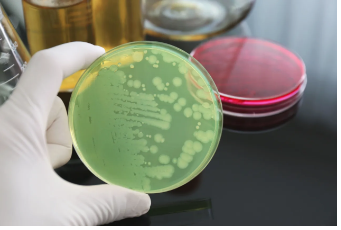Food Safety Spotlight | Pseudomonas in CEA Grows: Challenges and Solutions
Indoor Ag-Con will host a CEA Food Safety Pre-Event Workshop in conjunction with Ceres University on March 10, 2024. Looking ahead to this session, we’ve launched a monthly column to explore key issues and actionable improvements you can implement for your food safety and food quality processes. This month, the experts at AME Certified PCR Laboratories take a deep dive into Pseudomonas pathogens, addressing the problems they can cause for CEA crops and potential solutions.
———————————————————————————————————————————————————————————————————————–
Controlled environment agriculture (CEA) is a technology-based approach to produce high-quality, nutritious, and fresh food in a sustainable and efficient manner. CEA systems include greenhouses, vertical farms, hydroponics, aquaponics, and aeroponics, among others. CEA offers many advantages over conventional agriculture, such as reduced water and land use, increased crop yield and quality, reduced pesticide and fertilizer use, and year-round production. However, CEA also faces some serious challenges, such as high energy and capital costs, complex management and operation, and potential biosecurity risks. One of the major biosecurity risks in CEA is the occurrence of plant diseases caused by various pathogens, such as bacteria, fungi, viruses, and nematodes. Among these pathogens, Pseudomonas spp. are particularly problematic for CEA crops.
Pseudomonas spp. are ubiquitous gram-negative bacteria that can colonize various environments, including soil, water, plants, animals, and humans. Some Pseudomonas spp. are beneficial for plant growth and health, such as Pseudomonas fluorescens and Pseudomonas putida, which can produce plant growth-promoting substances, solubilize minerals, antagonize pathogens, and induce systemic resistance in plants. However, some Pseudomonas spp. are pathogenic for plants, causing diseases such as leaf spots, blights, wilts, rots, cankers, galls, and vascular disorders. Some of the most notorious plant pathogenic Pseudomonas spp. are Pseudomonas syringae, Pseudomonas aeruginosa, Pseudomonas cichorii, Pseudomonas viridiflava, and Pseudomonas corrugata. These pathogens can infect a wide range of CEA crops, such as lettuce, tomato, cucumber, pepper, eggplant, basil, mint, rosemary, and lavender.
Pseudomonas spp. can cause significant losses in CEA systems due to their high virulence, wide host range, rapid multiplication, diverse survival strategies, and resistance to antibiotics and disinfectants. Pseudomonas spp. can enter CEA systems through various sources, such as contaminated seeds, planting materials, irrigation water, tools, equipment, workers’ hands and clothes, insects and other vectors. Once inside the CEA system, Pseudomonas spp. can spread quickly through the recirculating water or nutrient solution, the humid and warm air, the plant-to-plant contact, or the mechanical damage caused by pruning or harvesting. Pseudomonas spp. can also persist in the CEA system for long periods of time by forming biofilms on surfaces, producing extracellular polysaccharides that protect them from desiccation and disinfection, or entering a dormant state that allows them to survive unfavorable conditions.
The management of Pseudomonas diseases in CEA systems is challenging due to the limited availability of effective control measures. The use of resistant or tolerant cultivars is not always feasible or sufficient, as Pseudomonas spp. can overcome host resistance by mutating or acquiring new virulent factors. The use of chemical pesticides is not desirable or permitted in CEA systems, as they can pose health and environmental risks, reduce crop quality and marketability, and select for resistant strains of Pseudomonas. The use of biological control agents (BCAs), such as beneficial bacteria or fungi that can antagonize or suppress Pseudomonas, is promising but not consistent or reliable, as BCAs can be affected by environmental factors, interactions with other microorganisms, or interference from the host plant. Therefore, there is a need for alternative or complementary control measures that can effectively prevent or reduce Pseudomonas diseases in CEA systems.
One of the potential solutions for managing Pseudomonas diseases in CEA systems is the use of an in-house qRT-PCR testing laboratory. In house laboratory systems deliver in-house testing systems to food production facilities featuring qRT-PCR (DNA), GCMS (gas chromatography-mass spectrometry), and NGS (next-generation sequencing) testing systems. qRT-PCR is a molecular technique that can detect and quantify small amounts of DNA in a sample by amplifying specific target sequences using primers and probes. qRT-PCR is recognized as the most accurate form of testing for food and human disease identification because it is highly sensitive and specific and can detect small amounts of DNA in a sample. qRT-PCR testing works by amplifying small amounts of DNA in a sample, making it easier to detect and identify. This makes it ideal for identifying the source of food contamination, as well as identifying the source of a human disease.
The benefits of using an in-house qRT-PCR testing laboratory for managing Pseudomonas diseases in CEA systems are manifold. First, it can provide fast and actionable data that can help the CEA facility to prevent or reduce Pseudomonas contamination and infection by implementing timely and appropriate control measures. Second, it can reduce the cost and time of testing by eliminating the need to send samples to external laboratories and wait for the results. Third, it can improve the quality and safety of the CEA products by ensuring that they are free from Pseudomonas and other pathogens and meet the regulatory and market standards. Fourth, it can enhance the reputation and credibility of the CEA facility by demonstrating its commitment to food safety and quality assurance.
Pseudomonas spp. are serious threats to CEA systems that can cause significant losses in crop yield and quality. The management of Pseudomonas diseases in CEA systems is challenging due to the limited availability of effective control measures. One of the potential solutions for managing Pseudomonas diseases in CEA systems is the use of an in-house qRT-PCR testing laboratory. PCR based laboratories provides in-house testing systems that can rapidly and accurately identify Pseudomonas spp. and other pathogens in the CEA system and provide fast and actionable data that can help the CEA facility to prevent or reduce Pseudomonas contamination and infection by implementing timely and appropriate control measures.
About AME Certified PCR Laboratories ![]()
AME Certified PCR Laboratories delivers in-house testing systems to food production facilities featuring qRT-PCR(DNA), GCMS, and NGS testing systems. Learn more at https://hsg-ame.com/

References
Albright, L. D. (2019). Controlled environment agriculture: past, present, future. Agronomy, 9(12), 777.
Hwang, S. H., Park, M., Lee, J., & Lee, J. H. (2015). Pseudomonas aeruginosa as an opportunistic pathogen on plants: how are they recognized?. Journal of microbiology (Seoul, Korea), 53(4), 207.
Kupferschmied, P., Maurhofer, M., & Keel, C. (2013). Promise for plant pest control: root-associated pseudomonads with insecticidal activities. Frontiers in plant science, 4, 287.
Mittelberger, C., Obkircher, L., Oberkofler, V., Ianeselli, A., Kerschbamer, C., Gallmetzer, A., … & Janik, K. (2020). Development of a universal endogenous qPCR control for eukaryotic DNA samples. Plant methods, 16(1), 1-11.
Song, Y., Wang, Y., Guo, D., & Jing, L. (2019). Selection of reference genes for quantitative real-time PCR normalization in the plant pathogen Puccinia helianthi Schw. BMC plant biology, 19(1), 1-12.
